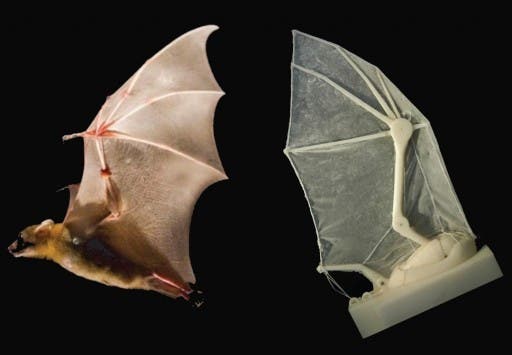
For some time now, researchers have been experimenting with the idea of an aircraft that operates with flapping wings, just like insects or birds do, instead of conventional flat and long wings. The idea is that flapping wings allow a much greater degree of control and stability, allowing the aircraft to perform maneuvers otherwise impossible. Still, such concepts are very difficult to implement and there’s still a lot of science behind these flapping wing dynamics to be uncovered, before a working, manned model can be made.
Steps in this direction are made constantly, and most recently researchers at Brown University developed a robotic bat wing that mimics that of a real fruitbat wing, which has allowed them to gain new insights into flapping flight dynamics in bats – the function of ligaments, the elasticity of skin, the structural support of musculature, skeletal flexibility, upstroke, and downstroke.
The robot wing is attached to a force transducer in a wind tunnel that records the aerodynamic forces generated by the moving wing. By measuring the power output of the three servo motors that control the robot’s seven movable joints, researchers can evaluate the energy required to execute wing movements. Testing showed the robot can match the basic flight parameters of bats, producing enough thrust to overcome drag and enough lift to carry the weight of the model species.
This kind of data could have never been possible to generate, since real life bats can’t fly when connected to monitoring and recording instruments – they’re kind of bugged by it. But that’s not an issue now, since the researchers are even more contempt with their artificial model. With it, they can change and adjust any kind of parameter and see which are the most important in controlling flight dynamics.
“We can answer questions like, ‘Does increasing wing beat frequency improve lift and what’s the energetic cost of doing that?’” said Joseph Bahlman, a graduate student at Brown who led the project. “We can directly measure the relationship between these kinematic parameters, aerodynamic forces, and energetics.”
To understand just how valuable these new insights have been, let’s take a look at wing folding. Previously, scientists were led to believe that birds would fold their wings during flight from time to time to save energy. Test runs with the robotic bat wing, however, have shown that this behavior is all about generating lift.
In a flapping animal, positive lift is generated by the downstroke, but some of that lift is undone by the subsequent upstroke, which generates negative lift. By running trials with and without wing folding, the robot showed that folding the wing on the upstroke dramatically decreases that negative lift, increasing net lift by 50 percent.
The next step is to start playing with the materials,” Bahlamn said. “We’d like to try different wing materials, different amounts of flexibility on the bones, looking to see if there are beneficial tradeoffs in these material properties.”
Check out the Brown University below detailing the bat robotic wing study.
Findings were reported in the journal Bioinspiration and Biomimetrics.


